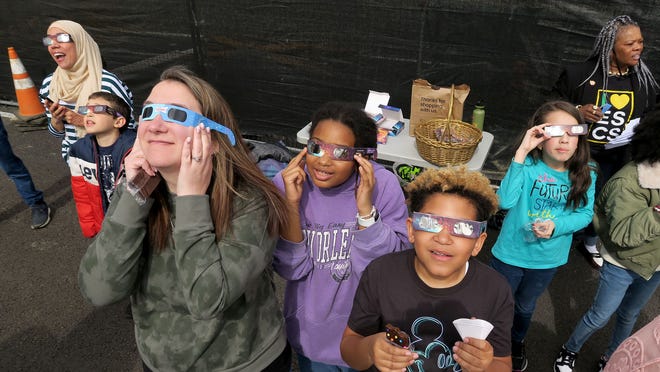
On the day of the eclipse, one place to witness the alignment of the sun, the moon and the Earth was at the Delaware Museum of Nature and Science. Both indoors and out, the institution was set up to excite, enlighten and educate guests about nature, the environment and the celestial event.
Attendees had the opportunity to explore regular museum exhibits and participate in eclipse-inspired hands-on activities. Those included NASA’s live stream, a demonstration highlighting the differences between solar and lunar eclipses, and a hands-on activity illustrating star formation.
As time for the eclipse drew near, the outdoor patio and grassy meadow became the focal point. Visitors exchanged spare eclipse glasses, laid out blankets and eagerly awaited Delaware’s view of the cosmic spectacle.
Alternative viewers if you don’t have glasses
Outside, telescopes and a projection screen had been set up to offer an exceptional eclipse viewing experience. For safety reasons, visitors were unable to observe the eclipse directly through the telescope. Instead, the telescope’s view was projected onto a screen, sparking excitement as visitors gathered around to catch a glimpse of the image.

Through the powerful lens of the telescope, two sunspots were visible. One of the museum guides explained that although the sunspots appeared tiny on the projection, they were actually as large as the Earth.
The nature and science center also had a station for attendees to make their own pinhole viewers. Made of paper, the craft allows people to safely observe an eclipse by directing sunlight through tiny holes and projecting the image onto a surface like a wall or the ground. Recalling her childhood experiments with a camera obscura, Newark resident Mari Weiss, a self-proclaimed science nerd, fashioned her version from the pinhole viewer. Weiss said her camera obscura projects the image inside the box rather than onto the ground.

Happy to describe how it worked was Sunjay Kulkacek, a science teacher at Shue-Medill Middle School. Like Weiss, Sunjay Kulkacek also constructed a viewer, but his was made from a tissue box.
Kulkacek explained that since light travels in a straight line, any light coming from the sun goes directly in. Light slightly higher will go down, while light slightly lower will go up, resulting in an image of the sun being projected through the pinhole onto the screen. This method allows you to safely observe and even photograph the eclipse without worrying about damaging your camera.
“It is not as fantastic as looking at it with the eclipse glasses, but it’s a fun thing to play around with,” Kulkacek said. The teacher said his love of science led him to take the day off to attend the event with his family but he looked forward to discussing this experience with his students and learning about theirs.

The place to be for nature and science
Don Dinsmore, a resident of Garnet Valley, eagerly planned to watch the solar eclipse with his grandchildren — 3-year-old Elin and 7-year-old Otis — along with their 14-year-old family friend Quinn Olinger. Having missed the 2017 eclipse, Dinsmore said he was determined not to miss this one. He purchased eclipse glasses well in advance and intended to view the full eclipse. However, because of to the long drive to a location in the path of totality, Dinsmore opted to stay closer to home.
He brought the kids along for the experience and looked forward to witnessing the peak coverage of the eclipse together. Glad to be out of school for the moment, Quinn shared that he almost didn’t make it to see the eclipse because his school initially prohibited students from leaving to watch the event. They reversed their decision at the last minute. Elin and Otis enthusiastically peered through their glasses before running off to play.
The event’s excitement might have been overlooked by some attendees. Amid the crowd, four baby rabbits were found hiding, their den located next to the telescope station. A visitor managed to catch one tiny bunny and attempted to return it to the den, but it quickly scampered away. An employee from the museum reassured everyone that the baby rabbits were old enough to fend for themselves and would return to the den once things quieted down. The unexpected encounter with the baby rabbits brought an additional touch of wonder and joy to the memorable eclipse viewing experience.
You can contact reporter Anitra Johnson at [email protected].
